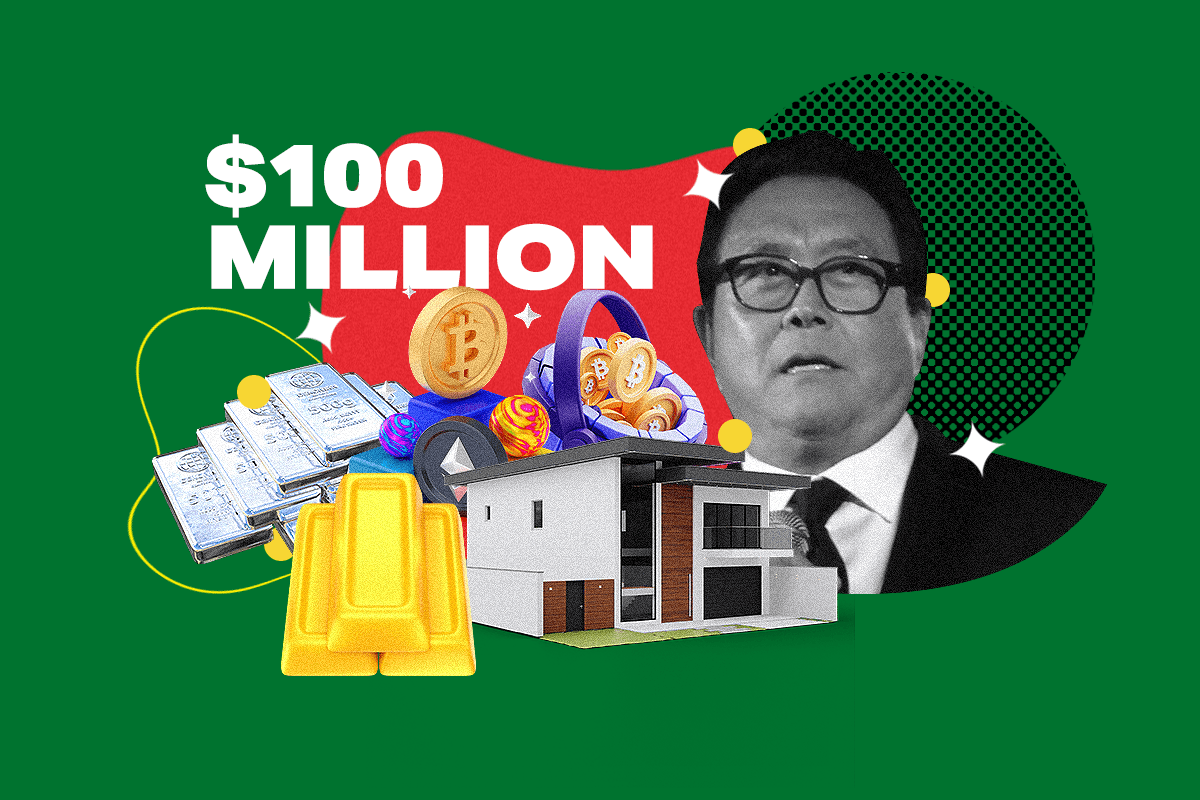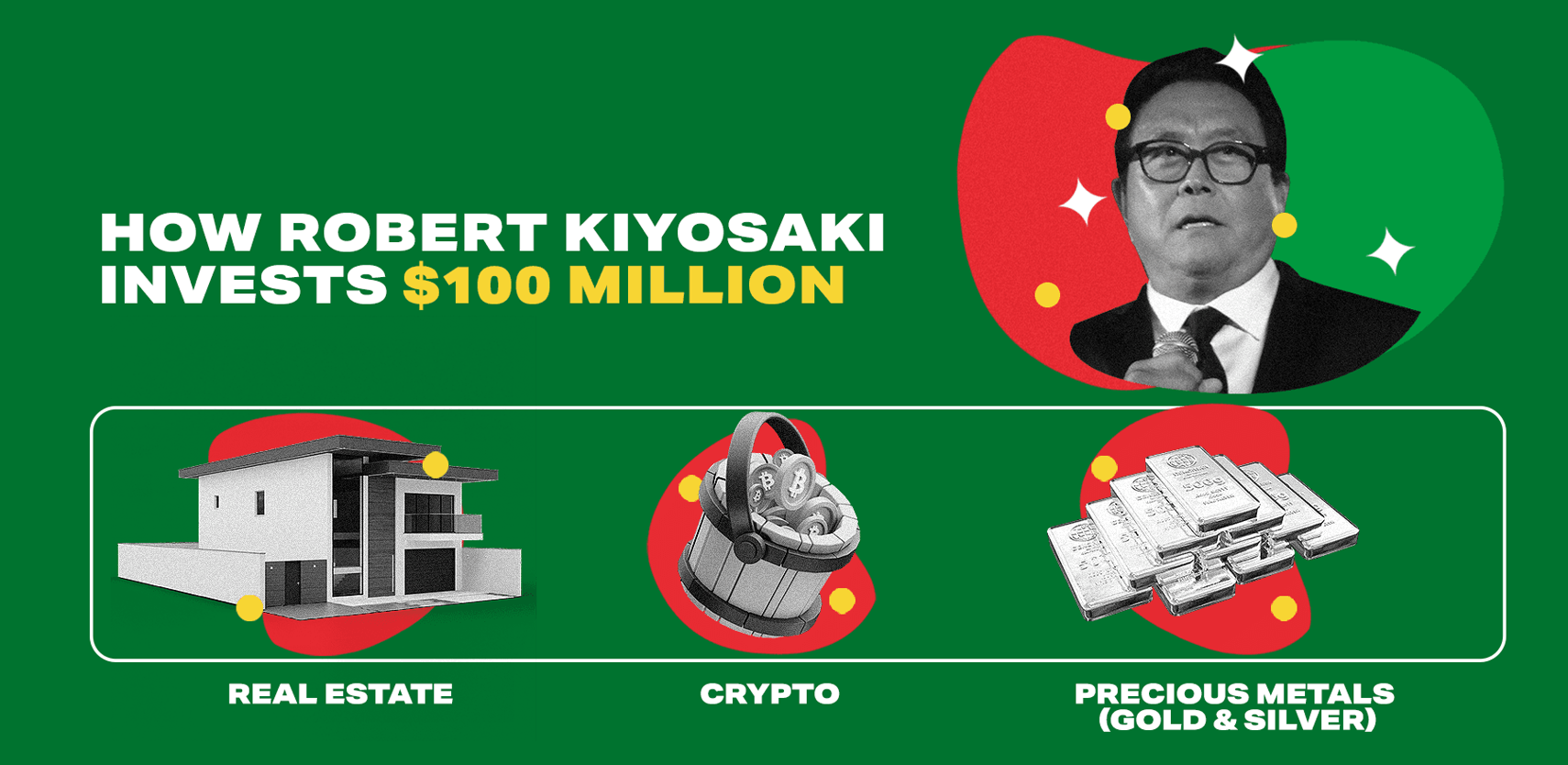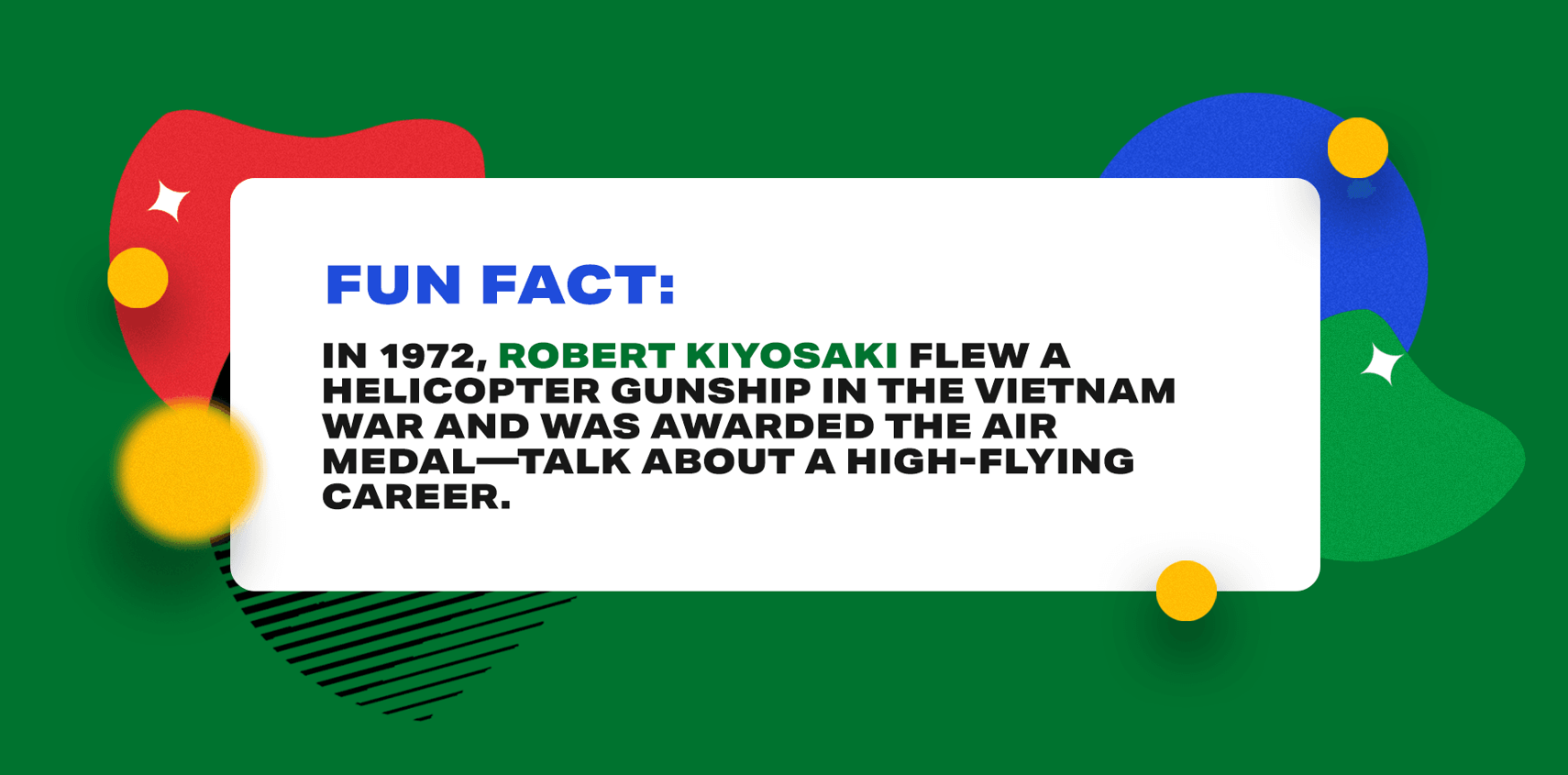Rich Dudes│ How Robert Kiyosaki’s Net Worth Reached $100M

Robert Kiyosaki’s secrets to wealth made him worth $100 million.
From real estate to gold to book royalties, learn how the ‘Rich Dad’ author built a nine-figure fortune.
Many companies on MoneyMade advertise with us. Opinions are our own, but compensation and in-depth research determine where and how companies may appear.See disclosure.
Robert Kiyosaki, born April 8, 1947, in Hilo, Hawaii, is a self-made millionaire entrepreneur, real estate investor, financial adviser, and author of international bestsellers.
Growing up, Robert studied at the U.S. Merchant Marine Academy and graduated as a deck officer in 1967. He briefly served in the Vietnam War and earned a medal for his service.
Rich Dad Education is estimated to be worth more than $20 million, with over 26 million copies of the Rich Dad books sold worldwide.
In the mid-1970s, Robert moved to New York City to work at Xerox before founding two unsuccessful businesses. Robert made his fortune when he changed his focus to writing and investing. In 1997, Robert Kiyosaki founded Cashflow Technologies, Inc., a finance and business education company that owns and operates Rich Dad and Cashflow.
Through smart investments, Kiyosaki found financial success in real estate while profiting from his numerous books, educational activities, and financial training seminars. He’s published 30 books and sold nearly 50 million copies worldwide. As of August 2022, Robert Kiyosaki’s net worth is over $100 million.
Robert Kiyosaki net worth at a glance:
| Net worth | $100 million |
| Born | April 4, 1947 |
| Nationality | American born in Hilo, Hawaii |
| Became a millionaire at | 50 years |
| Occupations | Entrepreneur, writer, investor, motivational speaker, business coach |
| Sources of wealth | Book royalties, investments, and real estate. |
| Asset classes | Real estate, precious metals, and crypto. |

How Robert Kiyosaki made his money
Robert Kiyosaki is a shining example of how smart investing can make a big difference. With a net worth of over $100 million and a monthly income of at least $1 million, the well-known financial guru has come a long way since his first venture in 1972, when he became a gold investor.
Since then, Kiyosaki has invested in multiple businesses, real estate, and stocks and has become a household name in financial literacy and investing education. He espouses financial freedom by adopting the habits and behaviors of rich people.
In 1977, he founded Rich Global LLC, a conglomerate specializing in manufacturing, retail operations, and financial education. His first book, Rich Dad Poor Dad, published in 1997, launched Robert Kiyosaki’s career. Rich Dad Poor Dad was a New York Times Best Seller for six years straight and has since sold over 32 million copies. He’s also hosted high-tier seminars that raked in hundreds of thousands of dollars.

Robert Kiyosaki’s ‘Rich Dad Poor Dad’ book sold over 32 million copies worldwide.
Source: publisherweekly.com
The most significant advancement came in 1997 when Kiyosaki and Kim Kiyosaki established Cashflow Technologies, Inc—a financial education company operating under the Rich Dad brand.
In 2013, Robert delved into crypto—investing in bitcoin and Ethereum, and soon became one of the most popular crypto enthusiasts. He has over 2.5 million followers on Twitter and two million subscribers on his YouTube channel.
The ‘Rich Dad’ brand
In 1997, Kiyosaki published Rich Dad Poor Dad. The book, originally self-published before being picked up by Warner Books, became a New York Times bestseller, staying on the list for over six years.
The Rich Dad brand, which consists of books, seminars, and audio material, focuses on personal finance education and wealth building. The brand was built largely off Kiyosaki’s first book and subsequent titles released under the Rich Dad brand name.
In 2000, Oprah Winfrey featured Kiyosaki on her show, bringing his message of ownership and passive income to an even broader audience. Kiyosaki went on to write 26 books and collaborated with Donald Trump on two titles, Why We Want You to Be Rich and Midas Touch.
Kiyosaki created a board game called Cash Flow 101—available online. He also has books and other projects focused on financial education for kids. Apart from authoring Rich Dad Poor Dad and other books, Kiyosaki owns and operates the Rich Dad brand comprising articles, videos, games, information about personal finance coaching, and workshops.
The Rich Dad brand has become an international sensation. With a presence in over 100 countries, Rich Dad has established itself as a top personal finance education company.
How Robert Kiyosaki invests his money
Kiyosaki puts his money where his mouth is—investing in real estate, precious metals, and crypto. He buys and holds real estate assets for long-term wealth, concentrating on cash-flow positive investments while avoiding speculating and flipping properties.
He also invests in gold and silver as a hedge against inflation and recommends investing up to 10% of one’s total portfolio in these metals. His cryptocurrency investments include bitcoin, Ethereum, and a few altcoins.
Startups: The Rich Dad Company
Rich Dad is a financially-focused company founded by Robert Kiyosaki in 1996. The company offers publications, educational courses, and games on financial planning and asset classes. Rich Dad has a weekly growth rate of 0.11%. The company also boasts over one million Twitter followers, four million unique visitors, 62,000 referring domains, and 13 patents. Recently, the company was debt financed with $352,000.
Rich Dad Education—the company’s educational arm, founded in 2006, has grown to over 20,000 students in the U.S., Canada, and the U.K. Rich Dad Education is estimated to be worth more than $20 million, with over 26 million copies of the Rich Dad books sold worldwide. The company provides a range of educational products and services, including free interactive webinars, workshops, and 1-on-1 Elite Mentor programs.
Venture capital plays a vital role in the US economy and innovation landscape, providing a crucial bridge between traditional financing and corporate research and development. According to Harvard Business Review, venture capitalists typically expect a return of 25% to 35% over the lifetime of their investments.
These investments focus on high-growth areas, like tech and internet companies, with high exit opportunities. Investing in venture capital can be financially attractive, as venture capitalists provide equity financing, which is typically unavailable to companies with less than $10 million in revenue.
This financing provides essential capital for startups and helps drive development-stage companies.
According to a LinkedIn News India study, venture capital investments expect to gain increased momentum in 2023 due to a potential for better performance than other major economies, higher consumption and credit off take indicators, and favorable policies.
Overall, investing in innovative companies can provide potentially high returns. However, it is necessary to do due diligence, as it is risky. Look for companies with a solid business model, a clear roadmap, and strong collaborations in multiple verticals to succeed.
Real Estate
Robert Kiyosaki’s love for real estate began at 26 when he bought his first property—a four-apartment unit in Hawaii. He then founded Rich Global LLC, in 1977, a real estate investment, manufacturing, retail, and financial education conglomerate.
Robert Kiyosaki has invested millions in real estate during his career, and his portfolio spans residential and commercial properties in Scottsdale, Arizona, Virginia, Georgia, Colorado, Nevada, and elsewhere.
Robert began with a modest $45,000 investment in a $65,000 house, which allowed him to net $40 monthly. When the market picked up, he sold the house for $95,000 and bought a 12-unit apartment complex for $300,000.
Just two years later, he sold the apartment complex for an impressive $495,000. He then reinvested that money into a 30-unit building that fetched $5,000 monthly. He eventually sold the building for an even more convincing $1.2 million. Robert Kiyosaki proves that taking risks does pay off and that avoiding failure is the surest way to miss out on success.
Real estate continues to be a viable option for investors desiring diversification and stability, according to the 2019 Emerging Trends in Real Estate survey by PricewaterhouseCoopers.
The 2019 Kellogg Real Estate Executive Survey reports that investors favor opportunities with predictable returns, and 90% of millionaires surveyed by CNBC confirm this, noting that real estate is one of the best investments today. Moreover, the real estate market provides attractive benefits—steady cash flow, capital gains, and more.

Precious Metals
Robert Kiyosaki has long advocated for real asset investments—particularly gold, and silver. He believes gold and silver are wise hedges against inflation and unpredictability, and he suggests people buy them over paper assets.
In 2017, he invested in the gold-backed token KaratCoin and acquired gold and silver bullion the following year in preparation for an economic recession. In 2019, Kiyosaki added palladium and platinum coins to his portfolio. And by 2020, he intensified purchasing physical gold and silver to protect against government deficits and money printing.
The London Bullion Market Association’s (LBMA) charts show that the price of gold and silver had risen from $1,800 and $22 in January 2022 to $1,900 and $24.81 per ounce in January 2023. This proves that precious metals continue to remain a safe investment due to their stability in terms of price.
Median returns for gold, platinum, palladium, and silver over the past year were 5.5%, 17.4%, 7.9%, and 8.2%, respectively. Despite some turbulence in the market in 2022, precious metals are performing well in 2023. Gold, for example, has outperformed inflation, rising 12.4% between the first and last LBMA fixes in 2022.
The increasing demand from UK customers for gold bars and coins supports this trend, with The Royal Mint selling 25% more gold and 29% more silver than in 2021 Silver prices have also been steadily increasing, up 4.96% since January 2021, and platinum prices are up 0.31% from January 2021.
Investors can leverage price fluctuations by trading futures contracts of precious metals. However, it is important to remember that precious metals are subject to market volatility and can experience rapid price shifts due to economic transitions.
Overall, precious metals have proven to be reliable. They have consistently outperformed inflation and other assets and have proven resilient amid economic volatility. As a result, they may be a wise addition to a diversified portfolio.
Crypto
Robert Kiyosaki is a well-known crypto enthusiast. His portfolio includes Bitcoin, Ethereum, and a few altcoins. Kiyosaki believes that Bitcoin will reach a price of $12.5 million by 2031—a poor dad today could be a rich dad tomorrow.
He advises investors to spread out risk by investing in an index fund-style portfolio of eight to ten different coins, and not to put more than 5% of their portfolio in cryptocurrencies. Kiyosaki uses debt to purchase Bitcoin and other crypto assets to avoid paying taxes on the profits.
2023 has been a good year for the cryptocurrency markets so far, with Bitcoin (BTC) rising 37% to close above $22,900, Ethereum (ETH) 30% to $1,577, and Solana (SOL) rising nearly 150%. These gains have given investors a sense of optimism that the crypto winter is over and that the coming months could bring even more growth. The Biden administration’s push for stricter crypto industry regulations underlines the renewed optimism.
Total digital asset market capitalization has dropped from a peak of $2.2 trillion at the end of 2021 to around $835 billion in December 2022, however, despite this downturn, the risk-adjusted returns of cryptocurrencies have still outperformed traditional risk assets such as US equities and US bonds.
Long-term holders of Bitcoin remain at 85%, indicating that the investment thesis remains intact. Ethereum has also seen a surge in network activity, further emphasizing its narrative as a leader in the multichain world.
Analysts predict that the bear market will be over at the beginning of 2023, followed by a bull market. Bitcoin is expected to resume its reign as the most dominant cryptocurrency, and Ethereum could gain greater regulatory clarity. Decentralized finance and Web 3 technologies could also be key players in the industry. Investors and traders should remain cautious as these markets can still be volatile and unpredictable.
Overall, the cryptocurrency market looks set to continue its growth in 2023. The Biden administration’s push for greater regulation and Bitcoin and Ethereum’s resilience demonstrates their maturation and investors’ faith in the sector. DeFi’s creative disruption and tokenization growth suggest that new and exciting use cases for cryptocurrency are just around the corner.
